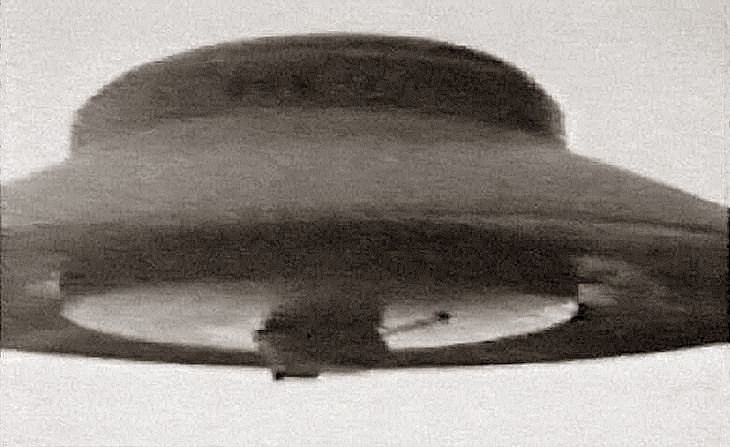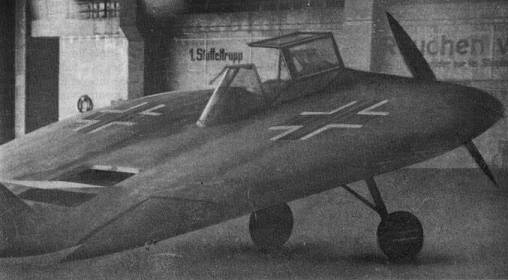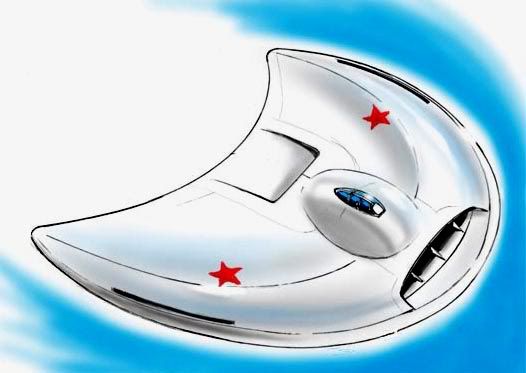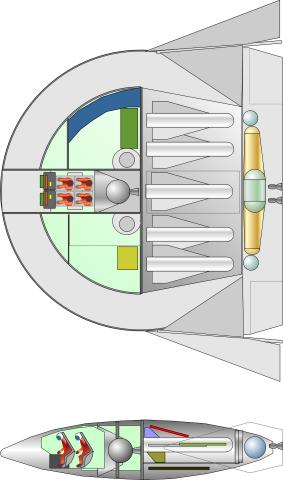




http://en.wikipedia.org/wiki/Nazi_UFOs
The haunebu was supposed to be flying discs powered by some electromagnetic stuff ans a vann de graff generator. Sorry im not good at electronics. it’s speed was 17000km/h (HaunebuI) It also carried a KSK ray gun. It had special armour to stand such speeds…as 17000km/hr. I guess its hard to believe…maybe it is a myth, you decide.
The correct designation is HANABU
They’re nonsense. If we had had flying saucers in 1945, we’d know about them today, they’d probably be in widespread use. In Germany we had SAMs (AAMs, AGMs), helicopters, ballistic missiles, jetfighters, all wing airframes, guided bombs, etc. either in use or development; all pretty futuristic stuff and probably military secrets back then, but common knowledge today. Why should the saucers be any different. The only logical conclusion is: they’re fiction.
I pretty sure that the Germans did try a flying saucer design
You are absolutely correct, my dear Mr. Drake – this is a complete nonsense! :roll:
For heaven’s sake, honorable gentlemen, are we here to discuss relevant and factual events and artifacts connected with the WW 2, or perhaps we have somehow altered our factual theme?
In a nutshell: presented “projects” are representing a pure example of unadulterated fantasy! A true Canadian genius - aeronautical engineer John C. Frost of A.V. Roe Canada Limited, was the only individual who actually produced a real “flying saucer”. Please, follow these links, and everything will be completely clear:
http://www.unrealaircraft.com/wings/german_discs.php
http://www.avroarrow.org/Avrocar/Avrocar.html
http://www.crystalinks.com/silverbug.html
http://www.laesieworks.com/ifo/lib/Project_Silverbug_Report.pdf
And no, honorable gentlemen: those projects were not unaccompanied. Here you have some very brief, but completely scientifically elaborated proposals and dreams:
http://www.rexresearch.com/wingless/wingless.htm
And if that is not enough, just give me a whistle: your old librarian will be able to provide some additional, scientifically completely verified materials as well. 
The fact remains - Germans did widely used saucers.
And God is my witness, some of those were indeed flying.
There was a story of a SS guy with a suitcase chained to his hand. When he left the local tavern, a tornado came and some saw a saucer-like shape…
There is alsop a story of a SS guy who came to an inn, asked for some saucers and started to throw them around the back-yard. the inkeeper was payed more than enough for the plates…
The “real” nazi flying saucers-the Sack AS-6

the guy who made it got aircraft parts from a nearby messerschmitt factory. It flew but was a very crappy plane.
American saucers
the XF5-U

more from Wiki
Early Development
According to Nazi mythology, the SS E-IV (Entwicklungsstelle 4) which was a development unit of the SS occult “Order of the Black Sun” was tasked with researching alternative energies to make the Third Reich independent of scarce fuel oil for war production. Their work included developing alternative energies and fuels.This group supposedly developed by 1939 a revolutionary electro-magnetic-gravitic engine which improved Hans Coler’s free energy machine into an energy Konverter coupled to a Van De Graaf band generator and Marconi vortex dynamo (a spherical tank of mercury) to create powerful rotating electromagnetic fields that affected gravity and reduced mass. It was designated the Thule Triebwerk (Thrustwork, a.ka. Tachyonator-7 drive) and was to be installed into a Thule designed disc.
Since 1935 the Thule Gesellschaft (Society) had been scouting for a remote, inconspicuous, underdeveloped testing ground for such a craft. Thule found a location in Northwest Germany that was known as (or possibly designated as) Hauneburg. At the establishment of this testing ground and facilities the SS E-IV unit simply referred to the new Thule disc as a war product- the “H-Gerät” (Hauneburg Device).
The existence of such a device is disputed by both physicists and historians and is widely regarded as a myth.
[edit] Continued Experimentation
For wartime security reasons the name was shortened to Haunebu in 1939 and was briefly designated RFZ-5 along with Vril‘s machines once the Hauneburg site was abandoned in favor of the more suitable Vril Arado Brandenburg aircraft testing grounds. The early Haunebu I craft of which two prototypes were constructed were 25 meters in diameter, had a crew of eight and could achieve the incredible initial velocity of 4,800 km/h, but at low altitude. Further enhancement enabled the machine to reach 17,000 km/h. Flight endurance was 18 hours. To resist the incredible temperatures of these velocities a special armor called Victalen was pioneered by SS metallurgists specifically for both the Haunebu and Vril series of disc craft. The Haunebu I had a double hull of Victalen. This name, Victalen, was first used by Obersturmbandführer of the SS Kapitän Blaubär by combining the english word for “Sieg Heil”, “Victory Hail” and the German word for “for everybody”, “allen”. Some sources however claim that he was inspired by the prostitute Alexandrina Victoria from the city of Talinn.[edit] The Experimental KSK Gun
The early models also attempted to test out a rather large experimental gun installation- the twin 60 mm KSK (KraftStrahlKanone, PowaRayCannon) which operated off the Triebwerk for power. It has been suggested that the ray from this weapon made it a laser, but it was not. The Germans called it an “anachronism” gun- not belonging to that time period or out of place.When a Vril 7 was downed by the Russians in 1945 a similar underbelly mounted KSK gun was destroyed with debris recovered from the battle site. Postwar the strange metal balls and tungsten spirals that made up the weapon could not be identified. But recently it has been speculated that the Triebwerk-connected balls formed cascade oscillators that were connected to a long barrel-shrouded transmission rod wrapped in a precision tungsten spiral, or coil to transmit a powerful energy burst suitable to pierce up to 4 in (100 mm) of enemy armor. The heavy gun installation, however, badly destabilized the disc and in subsequent Haunebu models lighter MG and MK cannon were supposedly installed. After the war allied troops found plans to build newer models with a top-secret weapon called Tokowe (TOrusförmigerKOtWErfer) in Deutsches Forschungsinstitut für Landwirtschaftliche Volkschemie in the village of Odenwald in Westphalia. They however could not be fully understood, because they were written in frankish dialect of German. They were ultimately thought to be lost during transport through the atlantic ocean and are now kept in Neuschwabenland next to the Book of Veles.
[edit] The Series Prototypes
According to legend, the Haunebu I first flew in 1939 and both prototypes made 52 test flights. In 1942, it is claimed, the enlarged Haunebu II of 26 meters diameter was ready for flight testing. This disc allegedly had a crew of nine and could also achieve supersonic flight of 6,000 to 21,000 km/h with a flight endurance of 55 hours. Both it and the further developed 32 meter diameter Haunebu II Do-Stra purportedly had heat shielding of two hulls of Victalen. The craft were supposedly constructed and tested between 1943-44. It is further claimed that the craft made 106 test flights.By 1944, the perfected war model, the Haunebu II Do-Stra (Dornier STRAtospharen Flugzeug/Stratospheric Aircraft) was tested. Two prototypes were built. These massive machines, several stories tall, were crewed by 20 men. They were also capable of hypersonic speed beyond 21,000 km/h. The SS had intended to produce the machines with tenders for both Junkers and Dornier but in late 1944/early 1945 Dornier was chosen. The close of the war, however, prevented Dornier from building any production models. Yet larger still was the 71 meter diameter Haunebu III. A lone prototype was constructed before the close of the war. It was crewed by 32 and could achieve speeds of 7,000 to 40,000 km/h. It had a triple Victalen hull. It is said to have had a flight endurance of 7 to 8 weeks. The craft made 19 test flights. This craft was to be used for evacuation work for Thule and Vril in March 1945.
Further plans for a 120 meter diameter Haunebu IV were in the works but no such craft is known to have been constructed before the end of the war.
[edit] Departure from Nazi Germany
It is believed that all of the mysterious Haunebu craft were evacuated to a sanctuary outside of Third Reich borders; to Neu Schwabenland, Antarctica - Base 211, constructed during the war.[edit] Postwar Sightings
In the years following the close of WW2, many Haunebu-shaped disc craft have been spotted all over the world leading to speculation that either the Third Reich survived in another part of the world (primarily in Argentina) and eventually took over the world in 1990 or that the Bonobos had captured the Thule and Vril technology and constructed similar craft.
- Author, Robert Dale Arndt Jr., “Disc Aircraft of the Third Reich (1922-1945 and Beyond)”, Ice Reich Productions
look here…
http://www.americanantigravity.com/technology.html
Might be fun to build one large enough to ride in:mrgreen::mrgreen:
The flugelrad autogyro-disccraft looks plausible enough.

Thank you very much, my dear Major. However, as an old technical aficionado I do prefer some more scientifically agreed, although pretty exotic solutions:
http://gltrs.grc.nasa.gov/citations/all/cr-2004-213312.html
http://gltrs.grc.nasa.gov/citations/all/cr-2004-213311.html
In the meantime, my dear Herr Major, I think that this… LFCSC (Luftwaffe Future Combat Systems Command) of yours better do start some more suitable preparations for 1948. You know – enemy is not sleeping! On the contrary… Have you seen that most recent report, presented by general Gehlen approximately… a month ago? No? Well, here you have one particular, highly intriguing excerpt:

Cheranovsky BiCh 19
Not even to mention those inescapable Americans… 
aeronautical engineer John C. Frost of A.V. Roe Canada Limited, was the only individual who actually produced a real “flying saucer”. Please, follow these links, and everything will be completely clear
Im trying hard not to become a troll:) but, if you believe that the avrocar was the only true flying pancake, what about the Viril models and the test models Flugelrad I and II?
Oh, I am trying hard not to act as an old-fashioned professor as well, my dear Major. 
However, I am enforced to ask you for a very simple favor: do you, by any chance, have one single snapshot of a factually produced, true-life German disc? You know… something like that infamous Sack AS 6 photo. If you do – please, post it here. I am assuring you that we will be delighted. 
And, yes - just one tiny additional techno-historical remark…
You see, my dear Major, we were told that Work on the Flügelrad I V-1 began between August and September of 1943 at the aerodrome at Prag, and that aforesaid machine left the hanger by its own means, lifting to 1 meter and flying for 300 meters before making a hard landing. Engines used were – as directly stated!– legendary BMW 003 jets.
And here we are faced with a factual problem. As we all know, a legendary Me 262 - much more elaborated German project that enjoyed a priority within RLM - was flown in November of 1941 with two BMW engines which both failed during the test, and that ill-fated prototype was obliged to return to the airfield on the power of the good old piston engine, which - luckily! - was still fitted.
Work on the unsuccessful BMW 003, however, continued and the improved engine was flight-tested under a Junkers Ju 88 in October of 1943, being finally ready for mass production only in August of 1944.
Being in possession of previously mentioned facts, and as a particular devotee of the German jet engines, I am eager to know what kind of the BMW 003 was actually used in that previously mentioned construction, my dear Herr Major.
You see, these… tiny technological discrepancies connected with the most fundamental part of every flying machine – engine – are completely non-existent in our celebrated AVRO case. So please - tell me everything you know about this knotty issue. Every usable information will be highly appreciated. 
Alright, you win…
so it is… the Haunebu is a fake…so far…
But, I mean is it possible for a Flugelrad to work? Are the designs plausible? would torque be a problem?
This group supposedly developed by 1939 a revolutionary electro-magnetic-gravitic engine which improved Hans Coler’s free energy machine into an energy Konverter coupled to a Van De Graaf band generator and Marconi vortex dynamo (a spherical tank of mercury) to create powerful rotating electromagnetic fields that affected gravity and reduced mass. It was designated the Thule Triebwerk (Thrustwork, a.ka. Tachyonator-7 drive) and was to be installed into a Thule designed disc.
I read somewhere that the term “Tachyon” was yet to be coined by the end of WWII. This happiily falsifies every alledged German wartime project using “Tachyonator” drives and the like.
As for the “Victalen”, the stupid stories of how this name came about isn´t the worst problem concerning this material. Germany by the time these Hanebu craft are supposed to have been built seriously lacked the materials for producing heat resistant alloys. This meant a severe reduction in turbojet engine life and no German turbocharger for aircraft engines reached mass production for the same reason. A tripple “Victalen” hull for some 70m diameter craft to go 21000km/h…
The only German saucer I can take serious is the BMW Flugelrads which might have existed.
But as we all know, all the real hardcore nazi´s flew to Antartica in these craft and lived happily ever after in their new civilisation 3000m under the ice:mrgreen:
And Major, I seroiusly suggest we should have a “Weird naxi myth” thread to bring it all to light and laugh or cry. You seem to be into the stuff, so you could start with fx. Neu Schwabenland:D
Apparently, it’s not just a modeller’s fantasy:
NAA Manned Bombardment and Control Vehicle
NAA Space Bomber
In the early 1960’s, one configuration studied by North American Aviation for the USAF space bomber study was this 12-m-diameter flying saucer design. A crew of four would have patrolled space for six weeks, with four thermonuclear weapons as armament.
This lenticular design was one concept for a manned reconnaissance and bomber spacecraft considered in 1962 by North American Aviation under a USAF study for deployment in the 1965 to 1975 period. The crew of four would have remained in orbit on missions of up to six weeks. A sensational article appeared in Popular Mechanics in November 2000 claiming that this was a nuclear-powered bomber, based on German World War II designs. It alleged it was part of a development lineage running through covert projects of the 1950’s such as Silverbug and Pye Wacket. It was further alleged that some honeycomb fiberglass/aluminum wreckage found in Australia in 1975 was related to actual flight tests of this vehicle - however the North American design was of much more exotic materials.
In fact, this was just one of four re-entry vehicle concepts (lifting body, winged, ballistic, lenticular) studied by North American for a USAF study on a manned orbital nuclear deterrent system. And rather than being based on the mentioned projects (which used the saucer shape for different reasons), the very likely source for the design was Alan Kehlet, a NASA aerodynamicist. He had advocated the lenticular re-entry vehicle for Project Apollo, and had been hired by North American just the year before.
Contrary to other allegations made in the Popular Science article, the spacecraft was not to be nuclear powered. A nuclear power source was one alternative considered for the 7 kW electrical system, but the engineering and safety analysis indicated a solar-thermal system would be more effective.
Perhaps more interesting was the systems concept considered. This was nothing less than a space-based version of the Minuteman ICBM system. The lenticular vehicle would just be the command post, waiting to authorize the go command to dozens of nuclear warheads orbiting nearby in unmanned weapons clusters. Except for the (unnecessary) aspect of having a manned platform to order an attack on the Soviet Union, this was similar to some Star Wars concepts of the 1980’s. The overall weapon system concept consisted of three basic orbiting components:
* The Manned Bombardment and Control Vehicle, which housed the basic control function in space and was itself armed with up to four thermonuclear weapons. This was the only portion of the system which was required to repeatedly reenter the earth's atmosphere. The Bombardment Vehicle could command, service, and launch on command the warheads from several Weapons Clusters.
* The Weapons Cluster, an unmanned weapons platform which integrated several thermonuclear weapons into a common orbiting package to facilitate handling and servicing. This included 320 kg of propellant for topping up the tanks of the weapons. A manned interorbital shuttle vehicle would travel from the Bombardment Vehicle to each cluster every six weeks, refueling the cluster propellant tank and servicing the weapons as needed. Top-off propellant requirements for the cluster and for the weapons would be small; estimated to be less than 22 kg per complete cluster per six week period.
* The orbiting thermonuclear weapon itself. Each winged re-entry vehicles was 7 m long, 50 cm in diameter, and had a wingspan of 1.4 m. Their total mass of 913 kg, included 90 kg of propellants. This would be sufficient for a delta-V of 300 m/s, enough, in conjunction with the delta wings, to attack Soviet targets, under the radar, without warning, up to two thousand kilometers left or right of the orbital ground track.
Bombardment and Control Vehicle
The Bombardment and Control Vehicle was the primary element of the system, and functioned as a manned orbital bombing system with an internal armament load of four winged reentry weapons and also acted as an orbital control and maintenance center for additional unmanned weapon clusters. The disc-shaped configuration was chosen for its greater usable volume available for weapons storage, crew accommodations, and for other unmentioned advantages. It had a basic diameter of 12.2 m and a gross launch mass of about 20,500 kg. The design operational mission was of six weeks duration, with a crew of four men at a nominal orbital altitude of 560 km. The vehicle incorporated a jettisonable crew compartment capsule for emergency escape and an interorbital shuttle service vehicle for inspection and maintenance of the weapon clusters.
The total projected planform area was 144 square meters which resulted in a normal reentry and landing wing loading of approximately one kilogram per square meter. The projected planform included the horizontal area between the disc and the straight trailing edge, which provided the flap area and also included the movable horizontal stabilizer surface located outboard of the vertical stabilizer surfaces. The hinged trailing edge surfaces inboard of the verticals functioned as elevators during subsonic flight and landing. The all movable horizontal surfaces located outboard of the verticals could be differentially actuated to provide roll control as well as simultaneously to provide pitch control, and were effective throughout the entire flight regime. The landing gear consisted of retractable skids mounted on the lower fuselage surface.
The useful load was 12,514 kg included 3650 kg for the four winged weapons. The vehicle was designed with four primary internal compartments: the living quarters, work area, armament bay, and crew escape capsule. Each compartment could be individually isolated from the other three, should a puncture or leak make one temporarily unusable. Repairs could be made to the damaged compartment while the crew used the remaining compartments for living and working quarters.
The crew capsule functioned as the vehicle control center during normal operation and as the crew escape capsule for an emergency abort of the mission. The escape capsule was actually a breakaway nose section of the vehicle, approximately 5.2 m long and 1.8 m wide. The capsule separated the crew living quarters from the work area and provided access to either compartment through a door in each side of the capsule. A sealant material around the doors prevented leakage of the cabin air during normal operation and was broken only when the capsule was separated from the primary vehicle.
The abort capsule contained the crew stations for boost and reentry, the vehicle control consoles, and the emergency power supply and life support equipment needed for an abort mission. Exit from the capsule after an abort was provided by the doors on each side, which served as the passageway doors between the compartments in normal operation.
Separation of the capsule from the main bomber vehicle was accomplished with a 220 kN thrust, spherical, solid propellant rocket engine located at the aft section of the escape capsule. The engine burned for 10 seconds and imparted an initial acceleration of 8.5 g to the capsule, sufficient to escape the 0.3 bar overpressure wave resulting from an explosion of the first stage booster during launch from the pad. The 10-second burning duration ensured sufficient altitude above the pad at burnout to permit recovery of the capsule with a parachute located in the forward nose section of the capsule, which was enclosed within a jettisonable nose fairing. The recovery chute was sized to limit the impact velocity of the capsule to approximately 7.5 meters per second.
…

It had a basic diameter of 12.2 m and a gross launch mass of about 20,500 kg. The design operational mission was of six weeks duration, with a crew of four men at a nominal orbital altitude of 560 km. The vehicle incorporated a jettisonable crew compartment capsule for emergency escape and an interorbital shuttle service vehicle for inspection and maintenance of the weapon clusters.
The total projected planform area was 144 square meters which resulted in a normal reentry and landing wing loading of approximately one kilogram per square meter.
This does not compute, even if the 4 men had that area and no craft:confused:
What a complicated weapons system!!!
And Major, I seroiusly suggest we should have a “Weird naxi myth” thread to bring it all to light and laugh or cry. You seem to be into the stuff, so you could start with fx. Neu Schwabenland
I thnk i will once Im back from vacation.
No no, it is possible. Have you never watched Mysterious of space? There are many pilots of commercial and military planes reporting UFO’s and I have seen many videos on TV about UFO’s and they look real to me. It is very possible that the material made from UFO’s are not traceable by modern technology. They may be invisible and flying all around us as we speak and we don’t know it.If we thought it was impossible to build the atomic bomb then the war would never have ended. Never think something is impossible. The Germans thought the Atomic bomb was impossible and look what happened. Maybe the germans were building ufo’s made out of superior technology we never heard of?. The germans were so advanced with rocketry so it is possible they incorporated rocket technology with UFO concepts. Anyways the point is, anything is possible.

